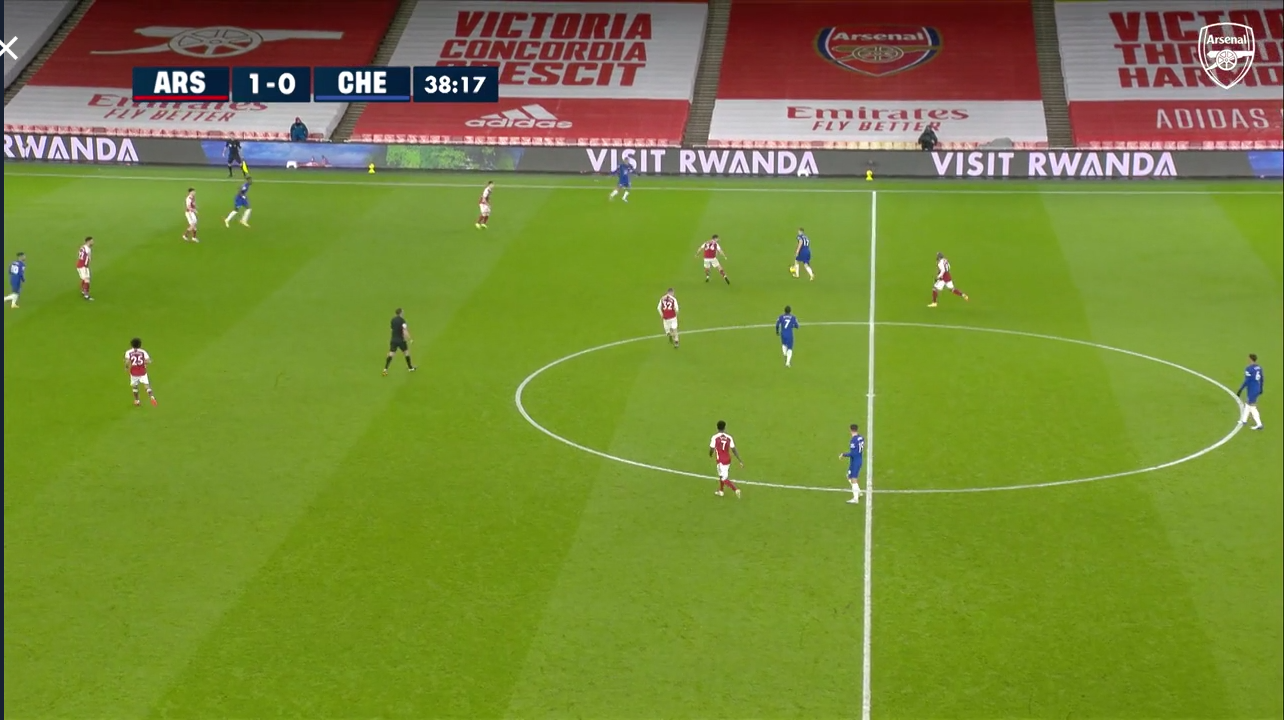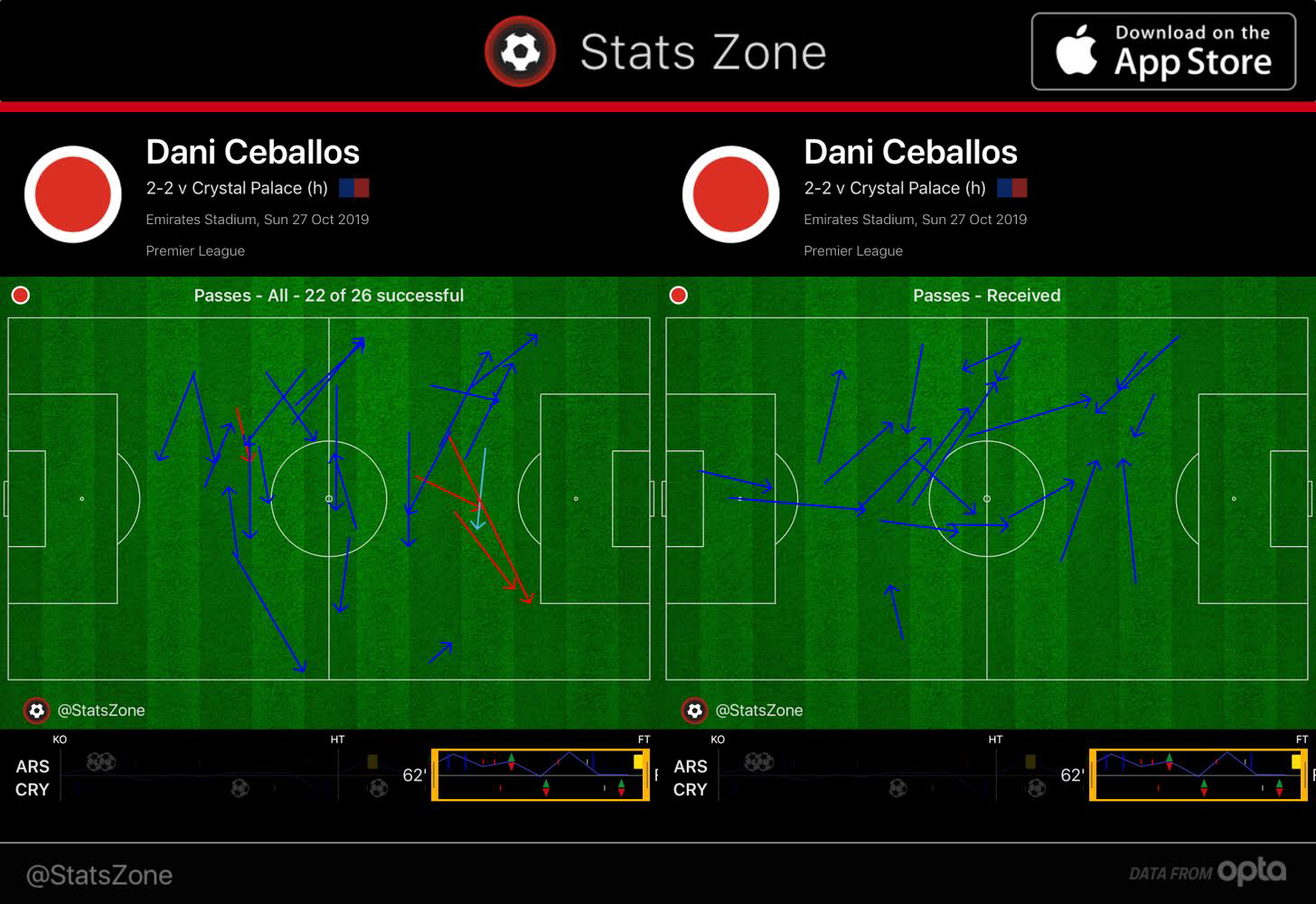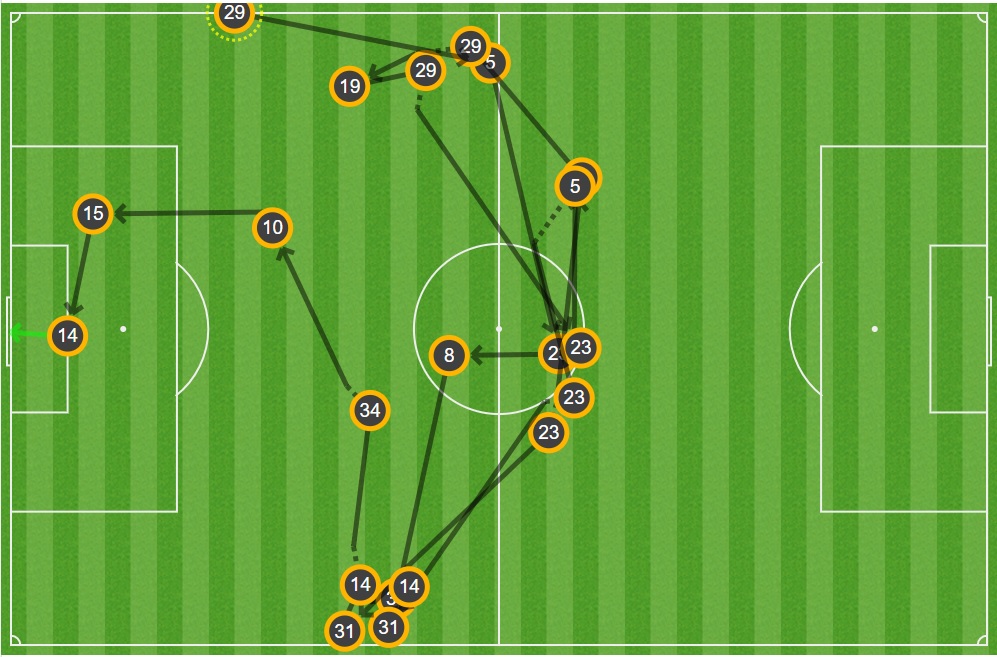
You’ve probably seen the video by now; Pep Guardiola is with Raheem Sterling on the training ground offering, very animated, one-to-one coaching with the winger on how to position his body to receive a pass, so that he can become a more effective attacking threat. The video then shows Sterling putting those teachings into practice by scoring a goal using almost exactly a mirror-copy of the movements Guardiola wanted him to produce.
In that season of 2017/18, Sterling exploded into form, scoring 23 goals in all competitions whereas previously he had never managed more than eleven. This transformation is outlined in an article for The Guardian, titled “The Romario-fication of Raheem”, which itself is an excerpt from Pol Ballus and Lu Martin’s book, Pep’s City: The Making of a Superteam. I will use a select few quotes from that piece, and things that Mikel Arteta has mentioned during these last two seasons about Bukayo Saka, to highlight how the Arsenal youngster’s development in some ways echo Sterling’s.
But to first go back to that goal. Sterling has just dropped off into a bit of space just outside the opposition area, having deduced, by scanning over his shoulder, that if a defender tries to engage him, he can simply spin behind. That split-second advantage is crucial because Sterling, as Arteta says, for one has the acceleration that is hard to stop, but also, he’s positioned his body shape perfectly to get the return pass that Ilkay Gundogan plays to him. “If he’s found a space about three metres off his defender but he’s half-turned towards the goal,” says Arteta, “then his sprint takes him much more quickly to a space where he can shoot and that’s going to cause the rival much more damage. It’s also a tactic, dropping off a little, so that your defender gets drawn into a position he mightn’t want to be in. It leaves space behind him and Raheem can attack that space. If it’s close to, or in the penalty area, they also have to hesitate before putting in a challenge.”
Certainly, it’s by using this type of movement which you feel has set Bukayo Saka apart these last few months, transforming him from a left-sided utility player to a right-winger who is arguably Arsenal’s chief outlet. His most recent goal, against Benfica in the first leg of the Europa League, showed exactly that as Saka was rewarded for his persistence to just want to be there, a menace, all the time operating on the fringes of Benfica’s offside-line and threatening to run behind. Indeed, he eventually did, turning home at the end of an attack which began because of the run he made, latching onto a brilliant long-pass from Dani Ceballos.
Pep Guardiola talks about Romario at Barcelona where, when as team-mates, when he saw the striker, on the “the half-turn, with his shoulder dipping as if he wanted the ball fed into his right or left foot, I knew he thought he could explode away from his marker. In that instance I always hit the pass immediately. Every time. I’d learned that his vision meant he’d had one eye on the distance between him and the opposition goal and the other eye on where the ball was. If he opened up his body shape like that and I fed him the ball, the defender was automatically done for.” For the Benfica goal above, there looks to be a fledgling relationship building between Ceballos and Saka, and indeed, in the first game that Saka was used by Arteta in the right-wing role, a 2-0 win in July 2020 versus Wolves, we can see Ceballos motioning to Saka during the drinks break how to make those runs (see here). The youngster has developed massively in that aspect in the last few months – certainly since Christmas – but with Ceballos featuring less, it is Thomas Partey now, who is the player from deep, that is the main benefactor of those runs. His passes to Saka over the top were a key factor initially in Arsenal’s 2-1 defeat to Wolves in February, and indeed, this analysis uses that game against Wolves and their encounter as mentioned already in the previous season where Saka was first used by Arteta at right-wing, as a convenient bookend to try and highlight how the youngster has improved with his movement behind.
Of course, there have been many standout moments for Bukayo Saka in between (and after) that period, the most high-profile being the comeback he inspired Arsenal to in the second-leg against Benfica. In that game he turned provider, stepping in from the inside-right channel to slip in Pierre-Emerick Aubameyang for the first goal, and then for the winner, crossing for the striker. In those two moments, Saka illustrated again his incredible ability on the ball, both in the effortlessly way he glides with it and his delivery of the final pass.
It’s with these strengths that he initially caught the eye of Unai Emery, the manager who first gave Saka his full debut as a 17-year-old, saying after his first start (a 1-0 win over Qarabag), that Saka showed great “personality to continue trying to do one-on-ones and break lines with his quality.” It would take a while for Saka to add a third dimension to his game – the ability to run behind – because emergency measures meant he was to be drafted into left-back and, he did so well there that many people felt it’d be his best position. (Indeed, Marcel Lucason, Arsenal’s Director of Development until November 2020, said: “Bukayo Saka is the best example of where we want to go with Arsenal. In the youth he was a winger, but because he is not Leroy Sané in the small spaces, he will not get further than the thirty best players in the world in that place. As an emerging wingback, he can become one of the best three in the world, because there is no one at speed to stop him and he can develop defensively with good coaching. With Mikel Arteta, these types of processes will hopefully gain momentum, because in terms of vision he is not far from what we want…”).
It’s interesting to note, however, that during the period Saka filled in there, Mikel Arteta was careful not to pigeon-hole him into any such role, often choosing to focus on in interviews, Saka’s continued development. Certainly, during his time at Manchester City, whilst he was being groomed as an eventual successor to Pep Guardiola, behind the scenes, Arteta was viewed as someone not necessarily devoted to the tactics board, but more as an educator, more invested in finding gains in the most tangible aspect of what makes a football team: the players. In Pep’s City: The Making of a Superteam, Arteta said his role there really was “to look for what’s missing in a player’s game. If I spot something, there’s no point in waiting for the guy to tell me about it. He might take three months to get round to it. Opening up like that to a coach, pointing out your own weaknesses, that’s not easy. What we do is create a safe place so that the players feel comfortable about sharing with us. That way we can then give them the tools to make the improvements they need.”
That was probably important for Bukayo Saka for whilst Arteta never publicly held reservations about his defensive acumen, Saka initially was reluctant to play at wing-back, saying that even when Ljungberg moved him to there, he was mainly willing to “master” the position so that he could learn how to “assist and score goals for the team.” Ljungberg still practiced with him how to run behind, but with needs must for Arsenal after Emery was sacked, Saka understood that this would have to be his role during the transition period.
Arteta always had it in the back of his mind to see Saka in the front three, and the tinkering of positions actually allowed him to gauge what Saka is good at, and then adapt his expectations based on that. “Bukayo is doing what he is doing because last year in certain moments he was managed and he was changing different positions,” Arteta said in January. “People would say ‘why? He needs to stick to one position’ but no; he needed to get richer in his understanding of the game. ‘He’s always a left-back, he needs to play left-back or on the left’ but no, he can play as an attacking midfielder as well.
“Then we see the cohesion he finds within the team and the position where he can be a game-winner, which he has the ability to do. Where is that position? Where are we missing a player like him? Then we try to fit him in and then we give him the games and consistency in the position, but first we have to find it.”
Saka first exploded into life on the right-flank in the 3-1 win against Chelsea, and his rapid adaptation was probably facilitated by Arteta finding a link-minded soul to partner him in Emile Smith-Rowe. With the pair now starting together in two of the three forward roles behind the striker, the manager’s previously fixed style now seemed naturally more fluid. Arteta explains his style: “For me, the way we occupy space and who is going to move in there is more important than the formation. And from there we have some very similar players that are not used to play in those positions so we have to keep changing the formation a little bit”. Thankfully, by finding Smith Rowe, he settled on the 4-2-3-1 and now with Martin Odegaard added to the side, he has the tools to keep developing Arsenal’s football.
Saka’s impact has stunted in the last few weeks, yet Arteta still continues to rely on him because in games where he doesn’t produce, his movement is still top-notch. In the 3-3 draw against West Ham, you could see how Saka was always buzzing in the spaces between the opponent’s defence and Odegaard especially seems to appreciate it.
Saka looks extremely natural now at right-wing, however, looking back to when Arteta first used him there, against Wolves last season, it’s quite notable how uncomfortable Saka found it playing in the role and being asked to do all these things. He still scored though, repaying Arteta’s faith, but the manager’s notes after the game was that the move was probably too early; he would have to revisit the transformation at a later date. “He has a lot of things to improve, that’s my message,” Arteta told Arsenal Digital. “He struggled in some moments in the game today in the first half. “I [played him] in a different position because I believe that he could hurt the opponent in there and he scored a really good goal. But what I like is that when things weren’t going for him, how he reacted and the personality to try and get the ball and fight for every ball and keep trying. He got rewarded.”
In the compilation above, (of only the first-half – recorded on my phone!), I kept the build-up longer so that it could show how clumsy Saka looked initially at right-wing, at one point (5:06), not paying attention to the opponent and running into him. There is a notable difference between his performance above, in comparison to his performance below 7 months later against Wolves the same opponents, as Saka’s movements are much cleaner, more aware of his surroundings. He seems to be able to compute better the multitude of factors he has to consider before making his runs and threatened to score a number of times. Indeed, he probably should have with the chance early on, springing onto Thomas’ long pass. It’s the type of movement Ceballos was coaching him during the drinks break in the first Wolves game (4:27). Not only is the body shape better, more at an angle, rather than back to play, he is aware that there are other ways to skin a cat; stretch the pitch to play it into a teammate in space, or use the one-two.
In the defeat, Saka also had another chance (1:25 below), getting onto a cut-back – which is actually an Arteta special, and it seems one Nicolas Pepe has mastered – which would have mirrored the goal that Saka actually scored in July 2020 against the same team (6:09 above).
Of course, because the off-the-ball improvements are more palpable, you might tend to overlook how effortless he makes things look on the ball. There is a graceful glide to the way he dribbles with it, displayed not only at right-wing, but when he played on the left-side, and from a starting position, the almost imperceptible shuffle that he has that lets him sidestep quickly from his opponents. That ability has probably been there from the start and likely didn’t need much nurturing, but encouraging. Fredrik Ljungberg notes that what separated him from the rest when Saka was younger was that simply “he knew what he was doing [at all times]. He played the right ball when he needed to…he’s not scared of things he can’t do and wants to get better all the time.”
The goal that Saka scored against Brighton was actually one that Ljungberg said he worked on with him, driving with the ball, because “in the beginning of his career, he got stuck with the ball, and he lost it” and praised his decision after to square the ball simply to Lacazette, “it’s not so easy”. For this goal, Saka showed his ability with his back to goal, something that stood out under Emery which suggested that he could adapt to a forward position. Under Arteta, he does this less often because his body shape is generally more at an angle – though he’s still supremely good at fending off defenders as shown by the clips I’ve posted against Wolves – which allows him to see more of the pitch, and with the way Arteta instructs his players to take up positions on the pitch, he is able to make more of a difference. As Arteta has said recently, “you can see that his teammates trust him.. and that’s great because then you don’t have one or two players, you have more players“. Saka has really learnt how to balance between coming to the ball and spinning behind, such that he is arguably the chief outlet for this Arsenal side, overtaking Aubameyang as their main goal-threat. Certainly that’s the area Saka confirms he’s focused on more now, and he will surely only get better. “Last year I created a lot of chances,” Saka said. “This season I’ve worked hard to improve my goal scoring.”
 Could this 3-1 win against Chelsea breathe new life into Mikel Arteta’s reign as Arsenal coach and kick-start the season? One would certainly hope so, because all the good things in display in this victory – high-intensity, purpose, confidence – have sorely been absent in the seven-weeks or so previously.
Could this 3-1 win against Chelsea breathe new life into Mikel Arteta’s reign as Arsenal coach and kick-start the season? One would certainly hope so, because all the good things in display in this victory – high-intensity, purpose, confidence – have sorely been absent in the seven-weeks or so previously.









